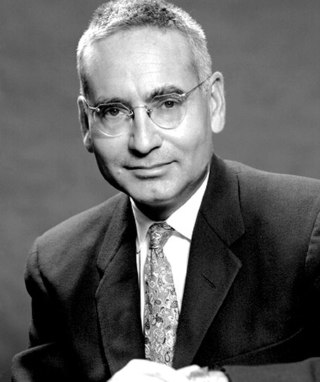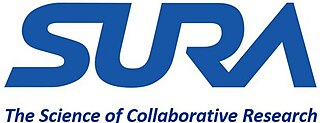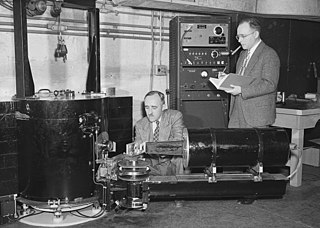
Oak Ridge National Laboratory (ORNL) is a federally funded research and development center in Oak Ridge, Tennessee, United States. Founded in 1943, the laboratory is now sponsored by the United States Department of Energy and administered by UT–Battelle, LLC.
Oak Ridge or Oakridge may refer to numerous locations in English-speaking countries - the most well-known being Oak Ridge, Tennessee, due to its part in the Manhattan Project. These and other meanings include:

Oak Ridge is a city in Anderson and Roane counties in the eastern part of the U.S. state of Tennessee, about 25 miles (40 km) west of downtown Knoxville. Oak Ridge's population was 31,402 at the 2020 census. It is part of the Knoxville Metropolitan Area. Oak Ridge's nicknames include the Atomic City, the Secret City, and the City Behind a Fence.
The Oak Ridge Institute for Science and Education (ORISE) is an asset of the U.S. Department of Energy that provides expertise in STEM workforce development, scientific and technical reviews, and the evaluation of radiation exposure and environmental contamination. Located in Oak Ridge, Tennessee, ORISE was established in 1992 to support DOE's mission by prepare the next generation of STEM professionals and by collaborating with the DOE Office of Science and other DOE programs, federal agencies, the scientific community, and industry to address scientific initiatives.

Alvin Martin Weinberg was an American nuclear physicist who was the administrator of Oak Ridge National Laboratory (ORNL) during and after the Manhattan Project. He came to Oak Ridge, Tennessee, in 1945 and remained there until his death in 2006. He was the first to use the term "Faustian bargain" to describe nuclear energy.
George Keene Schweitzer is an academic in chemistry and family history and local history. He has also studied history of science and philosophy of science, for which he was awarded the Sc.D.

Karl Ziegler Morgan, was an American physicist who was one of the founders of the field of radiation health physics. He was director of health physics at Oak Ridge National Laboratory from the time in the Manhattan Project late 1940s until his retirement in 1972.

William Grosvenor Pollard (1911–1989) was an American physicist and an Episcopal priest. He started his career as a professor of physics in 1936 at the University of Tennessee. In 1946 he championed the organization of the Oak Ridge Institute of Nuclear Studies (ORINS). He was its executive director until 1974. He was ordained as a priest in 1954. He authored and co-authored a significant amount of material in the areas of Christianity and Science and Religion found in books, book chapters, and journal articles. He was sometimes referred to as the "atomic deacon".
The Association of Public and Land-grant Universities (APLU) is a research, policy, and advocacy organization of public research universities, land-grant institutions, state university systems, and higher education organizations. It has member campuses in all of the United States as well as the District of Columbia, four U.S. territories, Canada, and Mexico.
Alvin William Trivelpiece was an American physicist whose varied career included positions as director of the Office of Energy Research of the U.S. Department of Energy (DOE), executive officer of the American Association for the Advancement of Science (AAAS), and director of Oak Ridge National Laboratory (ORNL). He was also a professor of physics and a corporate executive. Trivelpiece's research focused on plasma physics, controlled thermonuclear research, and particle accelerators. He received several patents for accelerators and microwave devices. He died in Rancho Santa Margarita, California in August 2022 at the age of 91.

The University of Tennessee, Knoxville is a public land-grant research university in Knoxville, Tennessee. Founded in 1794, two years before Tennessee became the 16th state, it is the flagship campus of the University of Tennessee system, with ten undergraduate colleges and eleven graduate colleges. It hosts more than 30,000 students from all 50 states and more than 100 foreign countries. It is classified among "R1: Doctoral Universities – Very high research activity".
John D. Petersen is an American chemist and educator who was president of the University of Tennessee system.
The ORNL DAAC for Biogeochemical Dynamics is a National Aeronautics and Space Administration (NASA) Earth Observing System Data and Information System (EOSDIS) data center managed by the Earth Science Data and Information System (ESDIS) Project. Established in 1993, the ORNL DAAC is operated by Oak Ridge National Laboratory in Oak Ridge, Tennessee, under an interagency agreement between NASA and the Department of Energy (DOE). Within the ORNL, the ORNL DAAC is part of the Remote Sensing and Environmental Informatics Group of the Environmental Sciences Division (ESD) and a contributor to the Climate Change Science Institute (CCSI).
Jimmy G. Cheek is Chancellor Emeritus and Distinguished Professor Emeritus of Higher Education in Department of Educational Leadership and Policy Studies at The University of Tennessee, Knoxville (UTK) and Former Director of the Postsecondary Education Research Center. He is also Professor Emeritus at the University of Florida. As the state's flagship research campus, UT Knoxville is currently ranked as a Top 50 public institution.

The Southeastern Universities Research Association, Inc. (SURA) is a non-profit association with member universities from the United States and Canada. SURA is focused on advancing science, research, and educational discovery.
Consortium for the Advanced Simulation of Light Water Reactors (CASL) is an Energy Innovation Hub sponsored by United States Department of Energy (DOE) and based at Oak Ridge National Laboratory (ORNL). CASL combines fundamental research and technology development through an integrated partnership of government, academia, and industry that extends across the nuclear energy enterprise. The goal of CASL is to develop advanced computational models of light water reactors (LWRs) that can be used by utilities, fuel vendors, universities, and national laboratories to help improve the performance of existing and future nuclear reactors. CASL was created in May 2010, and was the first energy innovation hub to be awarded.

Ernest Omar Wollan was an American physicist who made major contributions in the fields of neutron scattering and health physics.
Stephen E. Nagler is a Canadian condensed matter and materials science physicist. Nagler is the Corporate Research Fellow of the Oak Ridge National Laboratory (ORNL) and the Director of the laboratory's Quantum Condensed Matter Division. He is an adjunct professor with the Department of Physics at the University of Tennessee.

Clarice Evone Phelps (née Salone) is an American nuclear chemist researching the processing of radioactive transuranic elements at the US Department of Energy's Oak Ridge National Laboratory (ORNL). She was part of ORNL's team that collaborated with the Joint Institute for Nuclear Research to discover tennessine. The International Union of Pure and Applied Chemistry (IUPAC) recognizes her as the first African-American woman to be involved with the discovery of a chemical element.

David Edward Reichle is an American ecologist who worked at the Oak Ridge National Laboratory (ORNL). He is known for his pioneering research on the movement of radionuclides in the environment and the carbon metabolism of forest ecosystems. From 1967 to 1981 he was co-chair of Woodlands for the International Biological Programme. He served as Director of ORNL’s Environmental Sciences Division (1986-1990) and retired in 2000 as Associate Director.










